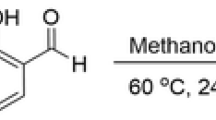Abstract
Catalytic polymerization of catechol was performed employing the cationic porphyrin and horseradish peroxidase (HRP) as catalysts. The obtained results demonstrate that the cationic metalloporphyrin is a more-efficient catalyst than the HRP in the catechol polymerization. The oxidative polymerization was carried out in the presence of polystyrene sulfonate (PSS) as a template. According to TGA data, poly(catechol) that is synthesized by porphyrin catalyst exhibits more thermal stability than the enzymatic catalyzed product. The GPC indicate higher molecular weight of polymer synthesized by porphyrin as a catalyst. Cyclic voltammetry measurements show that the synthesized polymers have convenient electroactivity. The poly(catechol) and its methyl and methoxy derivatives that are synthesized by porphyrin catalyst show low electrical conductivity.










Similar content being viewed by others
References
Kopf PW, Little AD (1988) Phenolic resin. In: Mark HF, Bikales NM, Overberger CG, Menges G (eds) Encyclopedia of polymer science and engineering. vol 11, 2nd edn. Wiley, New York, pp 45–95
Dordick JS, Marletta MA, Klibanov AM (1987) Polymerization of phenols catalyzed by peroxidase in nonaqueouse media. Biotechnol Bioeng 30:31–36
Aktaş N, Şahiner N, Kantoğlu Ö, Salih B, Tanyolaç A (2003) Biosynthesis and characterization of laccase catalyzed poly(catechol). J Polym Environ 11:123–128
Davis J, Vaughan DH, Cardosi MF (1998) Modification of catechol polymer redox properties during electropolymerization in the presence of aliphatic amines. Electrochim Acta 43:291–300
Solovskij MV, Denisov VM, Panarin EF, Petukhova NA, Purkina AV (1996) Synthesis of water-soluble biologically active phenol (or catechol) containing copolymers of N-vinyl-2-pyrrolidine. Macromol Chem Phys 197:2035–2046
Akkara JA, Kaplan LD, John VT, Tripathy SK (1996) In: Salamone JC (ed) The polymeric materials encyclopedia, vol 3. CRC Press, New York, pp 2116–2125
Dubey S, Singh D, Misra RA (1998) Enzymatic synthesis and various properties of poly(catechol). Enzyme Microbiol Technol 23:432–437
Uyama H, Kobayashi S (2002) Enzyme-catalyzed polymerization to functional polymers. J Mol Catal B 19–20:117–127
Liu W, Kumar J, Tripathy S, Senecal KJ, Samuelson L (1999) Enzymatically synthesized conducting polyaniline. J Am Chem Soc 121:71–78
Nabid MR, Entezami AA (2003) Enzymatic synthesis and characterization of a water-soluble, conducting poly(o-toluidine). Eur Polym J 39:1169–1175
Samuelson LA, Anagnostopoulos A, Alva KS, Kumar J, Tripathy SK (1998) Biologically derived conducting and water soluble polyaniline. Macromolecules 31:4376–4378
Nagarajan R, Tripathy S, Kumar J, Bruno FF, Samuelson LA (2000) An enzymatically synthesized conducting molecular complex of polyaniline and poly(vinylphosphonic acid). Macromolecules 33:9542–9547
Nabid MR, Sedghi R, Entezami AA (2007) Enzymatic oxidation of alkoxyanilines for preparation of conducting polymers. J Appl Polym Sci 103:3724–3729
Akkara JA, Senecal KJ, Kaplan DLJ (1991) Synthesis and characterization of polymers produced by horseradish peroxidase in dioxane. J Polym Sci Polym Chem 29:1561–1574
Ikada R, Uyama H, Kobayashi S (1996) Novel synthetic pathway to a poly(phenylene oxide). Laccase-catalyzed oxidative polymerization of syringic acid. Macromolecules 29:3053–3054
Milstein O, Nicklas B, Hüttermann A (1989) Oxidation of aromatic compounds in organic solvents with laccase from Trametes versicolor. Appl Microbiol Biotechnol 31:70–74
Okumura S, Iwai M, Tominaga Y (1984) Synthesis of ester oligomer by Aspergillus niger Lipase. Agric Biol Chem 48:2805–2808
Groves JT, Gross Z (1995) On the mechanism of epoxidation and hydroxylation catalyzed by iron porphyrins. Evidence for non-intersecting reaction pathway. In: Kessissoglon DP (ed) Bioinorganic chemistry. Kluwer, The Netherlands, pp 39–47
Nabid MR, Sedghi R, Entezami AA (2006) Synthesis of conducting water-soluble polyaniline with iron(III) porphyrin. J Appl Polym Sci 102:2929–2934
Nabid MR, Zamiraei Z, Sedghi R, Safari N (2009) Cationic metalloporphyrins for synthesis of conducting, water-soluble polyaniline. React Funct Polym 69:319–324
Little RG, Anton JA, Loach PA, Ibers JA (1975) Synthesis of some substituted tetraarylporphyrins. J Heterocycl Chem 12:343–349
Datta-Gupta N, Fanning JC, Dickens LL (1976) Some metal complexes of α, β, γ, δ-tetra-(4-pyridyl) porphin. J Coord Chem 5:201–207
Fleischer EB, Palmer JM, Srivastava TS, Chatterjee A (1971) Thermodynamic and kinetic properties of an iron-porphyrin system. J Am Chem Soc 93:3162–3167
Dunford HB (1991) Horseradish peroxidase: structure and kinetic properties. In: Everse J, Everse KE, Grisham MB (eds) Peroxidases in chemistry and biology, vol 2. CRC Press, Boca Raton, FL, pp 1–24
Goh YM, Nam W (1999) Significant electronic effect of porphyrin ligand on the reactivities of high-valent iron(IV) oxo porphyrin cation radical complexes. Inorg Chem 38:914–920
Traylor TG, Kim C, Fann WP, Perrin CL (1998) Reactions of hydroperoxides with iron(III) porphyrins: heterolytic cleavage followed by hydroperoxide oxidation. Tetrahedron 54:7977–7986
McMurry TJ, Groves JT (1986) Metalloporphyrin models for cytochrome P-450. In: Ortiz de montellano PR (ed) Cytochrome P-450: structure, mechanism, and biochemistry (B). Plenum, New York, pp 1–28
Amarnath CA, Palaniappa S, Puzari A, Rannou P, Pron A (2007) Solution processible and conductive polyaniline via protonation with 4,4-bis(4-hydroxy phenyl)-valeric acid: preparation and characterization. Mater Lett 61:4204–4207
Chen SA, Hwang GW (1997) Structure and properties of the water-soluble self-acid-doped conducting polymer blends: sulfonic acid ring-substituted polyaniline/poly(vinyl alcohol) and poly(aniline-co-N-propanesulfonic acid aniline)/poly(vinyl alcohol). Polymer 38:3333–3346
Author information
Authors and Affiliations
Corresponding author
Rights and permissions
About this article
Cite this article
Nabid, M.R., Zamiraei, Z., Sedghi, R. et al. Synthesis and characterization of poly(catechol) catalyzed by porphyrin and enzyme. Polym. Bull. 64, 855–865 (2010). https://doi.org/10.1007/s00289-009-0174-4
Received:
Revised:
Accepted:
Published:
Issue Date:
DOI: https://doi.org/10.1007/s00289-009-0174-4




